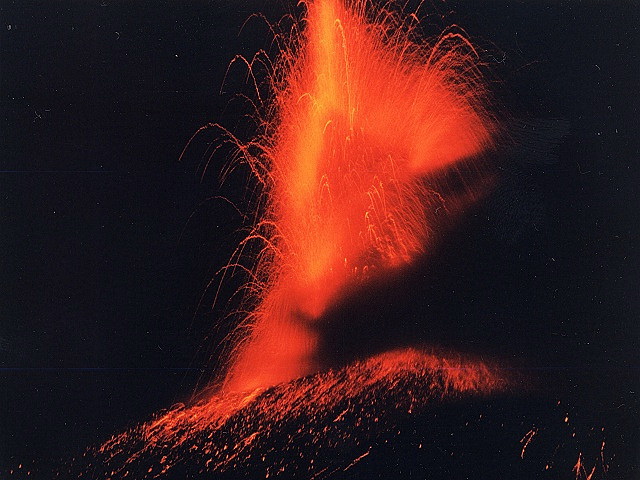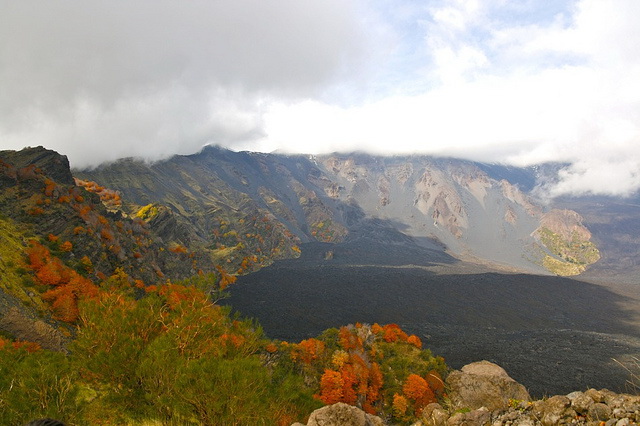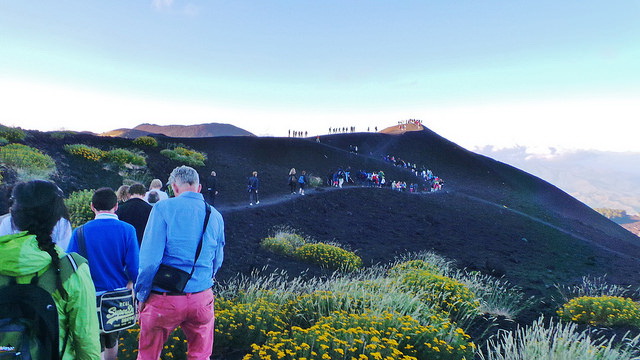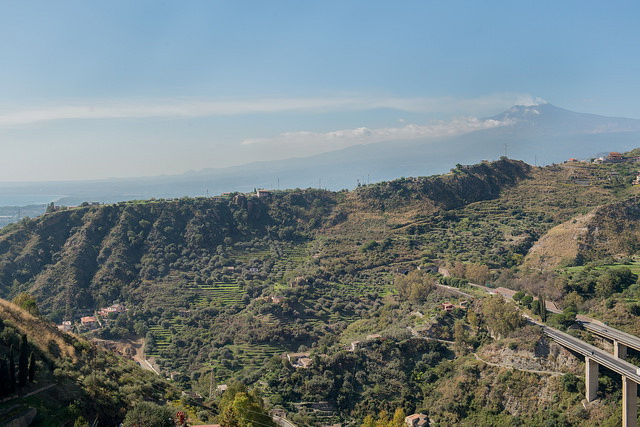With an area of almost 1200 km3, and a height of nearly 3330 meters, Etna is the largest volcano in Europe and the second among the most active volcanoes in the world. Its basal circumference alone is 140 km!
Mount Etna is one of the world’s most active volcanoes, yet thousands of people inhabit its lower slopes. And thousands more explore its black lava slopes or ski down them during the crisp Sicilian winters.
Its name comes from either Phoenician meaning “chimney” or from the Greek for “burn”. There are several live craters at the summit, and old craters and subsidiary cones litter Etna’s flanks.

It is a very lively and diverse volcano and since 2013 it was added as a World Heritage Site by UNESCO. Eruptions are a frequent occurrence, so the entire region has been carefully monitored since the mid-19th century.
According to UNESCO, Mount Etna has “one of the world’s longest documented records of historical volcanism.” Its eruptions occur both on its top, where at the moment there are four craters and on both sides that are dotted with hundreds of cones of various sizes.
The summit activity is the most frequent of the volcano, and can last for several years. The eruptions of the side instead have durations ranging from a few days up to a few years (e.g. the eruption of 1991-93).
Throughout history, Etna was also observed to blow smoke rings, a very rare occurrence among volcanoes. First observed in the 1970, last time Etna blew rings of 50 meters in diameter was in 2014.
Mount Etna dominates all of eastern Sicily. On clear days, it can be seen from further afield. Sicilians have a love/hate relationship with this mountain. Erupting, it deterred a Carthaginian invasion in 396BC. It enriches their soil with volcanic ash. It is one of the main attractions of the island. On the other hand, by constantly smoking, it broods on the horizon, casting a spell over everyone living in its shadow.
Mount Etna has been likened to a huge house cat, purring quietly, awakening every so often. Topped with snow or throwing up fire, it’s always been a hot destination.
History of Etna Eruptions
Mount Etna is one of the most active volcanoes that erupts frequently. Below is a timeline of the most notable eruptions, and also some of them captured in photos. Most recently, Etna was active in the summer of 2014, but the volcanic activity between January 2011 and February 2012 was more intense.
The biggest eruption in the 21st century occurred on the 13th of May 2008, when many earthquakes accompanied it. The lava continued to flow for more than 400 day afterwards
Between 1991 and 1993 Etna was very active. In 1992, a river of lava destroyed a resthome and threatened to engulf the town of Zafferana but the lava flow was diverted successfully. Volcanic activity in 1983 wiped out the old cable-car and tourist centre. Authorities exploded dynamite in the first successful attempt to divert a lava flow. The 1971 eruptions destroyed an observatory at the summit. Lava threatened villages and destroyed orchards and vineyards. In 1928, the railway at the foot of Mount Etna was cut and the villages of Mascali and Cerro were destroyed. In the 20th century, this was the only instance when an eruption led to the destruction of an inhabited area.
But the most destructive activities took place in 1669. Rivers of lava hit a dozen villages and headed towards Catania. Workers dug a huge trench — the first recorded attempt of diversion — but lava breached Catania’s city walls then pushed on to the sea. By the time the fireworks ended, Mount Etna had disgorged about 830 million cubic metres of lava.

Flora and Fauna on Etna
Mount Etna Flora

The flora of Mount Etna varies depending on the altitude.
At the base, the mountain is mostly occupied by crops, especially citrus (up until 500 meter high). Once, the lower slopes of the volcano were occupied by carob and wild olive, but in recent times these were replaced.
At higher altitudes (600 – 1000m above sea level) the vegetation was at a time characterized by forests of holm oak (Quercus ilex). Today these forests almost completely disappeared due to anthropogenic influence. They were substituted by vineyards, olive trees, almonds and pistachios on the western side and hazel on the northern side. The holm oak woods are still present on the western slope where one can also find plenty of Oriental hackberry (Celtis tournefortii).
Between 1000-1500m, the mountain is characterized by forests of downy oak (Quercus pubescens) and chestnut trees. On the eastern side one can find forests of Turkey oak (Quercus cerris). Above these forests there are black pines, for example the pine forests of Serra la Nave. Above the 1500 meter mark, pine trees as well as beech trees (Fagus sylvatica) can be found. In some areas, especially on the eastern side there are trees of Etna birch (Betula aetnensis), considered by some endemic to Mount Etna.
Above the 2450m mark very few plants can survive that adapted to the harsh environment like the French sorrel (Rumex scutatus). Above 3,000m altitude the continuous eruptive activity of Etna prevents any form of plant life to thrive.
Mount Etna Fauna
The fauna of Mt Etna is very diverse and more species of animals have been re-introduced here in recent years. Various species of snakes and lizards inhabit Etna and you can encounter them at different altitudes.
If you will hike the mountain it is very probable that you will encounter squirrels, hedgehogs, foxes, martens or porcupines. If you are very lucky, you will spot a wild cat as well. Regarding birds, Etna is home to owls, falcons or even golden eagles (but they are still very endangered).
Mount Etna Trails
Mount Etna is one of Sicily’s main tourist attractions. Travelers who want to climb to Mount Etna should take into account that the weather gets much colder on the mountain than on the valley or the coast next to it. Before trekking take the necessary safety precautions. Don’t venture alone on the mountain and take necessary supplies with yourself.
Very important! There are some areas on Mount Etna that are not recommended for hiking and are very dangerous. Always check if there is any volcanic activity on the mountain and which areas are not safe in that period. If you are near fumes, be aware that they can be toxic and try not to inhale them directly. Do not climb the top of the south east crater and do not climb down in the main craters.

Taking into account these precautions, below are some trails that you can follow.
You can trek the slopes of Mount Etna or take a 4WD drive and a guide and walk after the road ends. There are many good routes you can take and each one of them offers something different. The south east trail is one of the most popular ones. But the recent volcanic activity affected this area the most so you need to be more careful than usual.
It is best to take a local guide, otherwise there are sticks that signal the safe route.
- On the western side of Etna you can start at Monte Gallo that you can reach at the end of Nicolosi-Adrano road. At the end of this trail you reach the Rifugio della Galvarina (Galvarina forest refuge).
- Another easy hike is the Monte Frumento Supino. The twin craters above Rifugio Alpino are a must see.
- The Monte Nero degli Zappini Nature Trail is one of the most popular trails taken by visitors. It starts at Pinao Vetore.
- The Mount Zoccolaro Nature Trail is one of the most spectacular trails on Etna. On this trail you can get a good glance of the Valle del Bove and Calanna Valley.
- Unfortunately the Mount Zoccolaro trail is also one of the most dangerous ones and it is not advised for beginners.
- On the northern slope you can take the Casa Pirao to Monte Spagnolo to Cisternazza trail. It starts at Casa Pirao until the Mount Spagnolo beach wood.
Access to Mount Etna
Mount Etna is easily reachable through various ways. The nearby city of Catania is served by an international airport and there are daily buses running from Catania Nicolosi to Rifugio Sapienza, on the south side of the mountain. This bus leaves the railway station in Catania at 8:15 and tickets can be bought inside the bus. It departs back to Catania at 4:30 giving you enough time for a quick visit if that is what you want.
Alternatively, there are tour companies around Taormina that can arrange a stay for more days and guided tours around the park.

